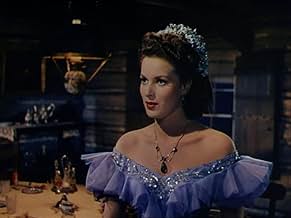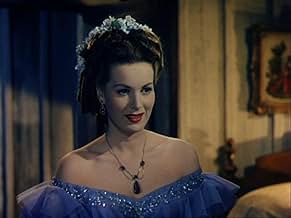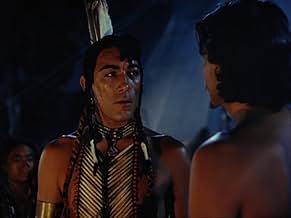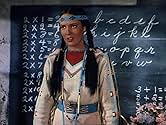VALUTAZIONE IMDb
6,4/10
1775
LA TUA VALUTAZIONE
Aggiungi una trama nella tua linguaThe story of William "Buffalo Bill" Cody, legendary westerner, from his days as an army scout to his later activities as owner of a Wild West show.The story of William "Buffalo Bill" Cody, legendary westerner, from his days as an army scout to his later activities as owner of a Wild West show.The story of William "Buffalo Bill" Cody, legendary westerner, from his days as an army scout to his later activities as owner of a Wild West show.
- Regia
- Sceneggiatura
- Star
- Premi
- 2 vittorie totali
Carl Andre
- Trooper
- (non citato nei titoli originali)
Arthur Aylesworth
- Pool Player Debunking Cody
- (non citato nei titoli originali)
Evelyn Beresford
- Queen Victoria
- (non citato nei titoli originali)
Edward Biby
- Sergeant
- (non citato nei titoli originali)
Sidney Blackmer
- Theodore Roosevelt
- (non citato nei titoli originali)
Billy Bletcher
- Short Man
- (non citato nei titoli originali)
William A. Boardway
- Washington DC Cafe Customer
- (non citato nei titoli originali)
Recensioni in evidenza
"Buffalo Bill" is a highly romanticized picture of 'Buffalo' Bill Cody. While IMDb is correct that most of the things in this biopic are actually based on Cody's real-life exploits, most of the relationship between him and his wife was pure hooey. Sadly, there was no great love in Cody's life--or if there was, it wasn't his wife! Most of their life was spent apart by his choice--and there were other women in his life. But, this image of Bill would not have gotten past censors back in 1944, so the studio fictionalized this aspect of his life. The rest, however, is reasonably accurate--something that surprised me as I watched the film. He was a scout for the US Army in the west, he fought in the Indian wars and he did start up an incredibly successful Wild West Show.
Another aspect of the film that struck me was its treatment of the American Indians--particularly the Cheyenne. It was odd, as the major roles of the 'Indians' were played by Linda Darnell and Anthony Quinn!!! This insensitivity was pretty much the way American Indians were portrayed in American films through the 1950s. HOWEVER, despite this insensitivity, the film did correctly assert that the Indian wars were forced on these people due to how they were treated by the government. And, in this way, the film was much more balanced than many westerns of the day.
Overall, a somewhat inaccurate film that looked nice and featured the excellent acting, as usual, by Joel McCrea. Worth seeing--just not exactly the Gospel! And, the final line of the film might make you throw up--so when that little kid in the audience stands up, PLUG YOUR EARS!!!
By the way, the film made one HUGE mistake. General Sherman NEVER said "The only good Indian is a dead Indian". This quote was actually from General Sheridan--though it's not exactly what he said. When he was asked what a good Indian was like, he said very succinctly "...a dead one".
Another aspect of the film that struck me was its treatment of the American Indians--particularly the Cheyenne. It was odd, as the major roles of the 'Indians' were played by Linda Darnell and Anthony Quinn!!! This insensitivity was pretty much the way American Indians were portrayed in American films through the 1950s. HOWEVER, despite this insensitivity, the film did correctly assert that the Indian wars were forced on these people due to how they were treated by the government. And, in this way, the film was much more balanced than many westerns of the day.
Overall, a somewhat inaccurate film that looked nice and featured the excellent acting, as usual, by Joel McCrea. Worth seeing--just not exactly the Gospel! And, the final line of the film might make you throw up--so when that little kid in the audience stands up, PLUG YOUR EARS!!!
By the way, the film made one HUGE mistake. General Sherman NEVER said "The only good Indian is a dead Indian". This quote was actually from General Sheridan--though it's not exactly what he said. When he was asked what a good Indian was like, he said very succinctly "...a dead one".
While as Biography, "Buffalo Bill" is probably as accurate as the depiction of Custer in "They Died With Their boots On", it is still excellent film making and a fine vehicle for stalwart Joel McCrea, who, despite performances in excellent non-westerns such as "Sullivan's Travels" and "Foreign Correspondent" was known primarily as a Cowboy Star.
I would also hold this film up as another example, along with John Ford's Cavalry Trilogy, of a film which depicted Native Americans as a noble race, victimized by the march of western civilization, long before the advent of films such as "Little Big Man" or "Dances With Wolves" The White Man is clearly the villain in this and the Ford films. Early on, Cody admonishes a Government representative, telling him that Yellow hand (Anthony Quinn, who also plays Crazy Horse in "They Died With Their boots On") is a Prince of his people, and should be treated as such.
Plus, if the reunion at the shooting gallery and the Wild West Show farewell scenes don't put a lump in your throat, better check your pulse.
I would also hold this film up as another example, along with John Ford's Cavalry Trilogy, of a film which depicted Native Americans as a noble race, victimized by the march of western civilization, long before the advent of films such as "Little Big Man" or "Dances With Wolves" The White Man is clearly the villain in this and the Ford films. Early on, Cody admonishes a Government representative, telling him that Yellow hand (Anthony Quinn, who also plays Crazy Horse in "They Died With Their boots On") is a Prince of his people, and should be treated as such.
Plus, if the reunion at the shooting gallery and the Wild West Show farewell scenes don't put a lump in your throat, better check your pulse.
I enjoyed watching the film "Buffalo Bill." Unfortunately close blood relations of Buffalo Bill were still living at that time, and they should have made an effort not to make errors.
Louisa Frederici met Cody in Saint Louis, and served out the end of the war there planning on making her his bride. They were married in her father's home (John Frederici) on South 8th Street in Saint Louis. They left right away for a steamboat to Kansas. Her father did not go along, and was NOT a Senator.
It is a fine film, and entertaining. When Bill Cody returned to the West in 1866 he was married! There was no Linda Darnell's character. Just once I would like for Hollywood to do an exact biography without changing the facts!
I am a Frederici descendant. Terry Alan Klasek Saint Louis, Missouri
Louisa Frederici met Cody in Saint Louis, and served out the end of the war there planning on making her his bride. They were married in her father's home (John Frederici) on South 8th Street in Saint Louis. They left right away for a steamboat to Kansas. Her father did not go along, and was NOT a Senator.
It is a fine film, and entertaining. When Bill Cody returned to the West in 1866 he was married! There was no Linda Darnell's character. Just once I would like for Hollywood to do an exact biography without changing the facts!
I am a Frederici descendant. Terry Alan Klasek Saint Louis, Missouri
A lavish Technicolor potboiler shot by Leon Shamroy, who later collected that year's Oscar for colour cinematography for 'Wilson'; although here the most spectacular scenes are obviously the work of Otto Brower's second unit, with the close ups of the leads shot back at the studio.
It commendably takes the side of the American Indian (represented here by Anthony Quinn and Linda Darnell, the latter wearing lots of makeup and the former very little of anything) against the vested financial interests back East, and also gives the plight of the buffalo a nod.
Maureen O'Hara thought her first western "would be forgettable, but it turned out to be one of the biggest moneymakers 20th Century-Fox had that year" and that Joel McCrea although "a very nice man, a good actor, but not rugged like Duke or Brian Keith". He's likeable, however and as usual gives the film heart.
It commendably takes the side of the American Indian (represented here by Anthony Quinn and Linda Darnell, the latter wearing lots of makeup and the former very little of anything) against the vested financial interests back East, and also gives the plight of the buffalo a nod.
Maureen O'Hara thought her first western "would be forgettable, but it turned out to be one of the biggest moneymakers 20th Century-Fox had that year" and that Joel McCrea although "a very nice man, a good actor, but not rugged like Duke or Brian Keith". He's likeable, however and as usual gives the film heart.
The story of Buffalo Bill (Joel McCrea) is showed basically in two parts, beginning in 1877: in the West, when he meets his future wife Louisa Frederici Cody (Maureen O'Hara), his friendship with the Indians, specially with Yellow Hand (Anthony Quinn), and his work, as an explorer of the wild West, ending when his wife returns to the East with his baby son and with a battle against the Cheyenne. The second part begins when he moves to the East, loses his son, separates from his wife, defends the Indians in the civilized society until his retirement. I liked this movie a lot: the battle scenes are fantastic, the story has action, romance, drama and is not corny. I do not know whether the facts are correctly presented or not, but as a movie, it is a great entertainment, recommended for all audiences. Maureen O'Hara's beauty is stunning. My vote is nine.
Title (Brazil): `Buffalo Bill'
Title (Brazil): `Buffalo Bill'
Lo sapevi?
- QuizMuch of Cody's life as depicted in the film was true: He did fight to the death with Chief Yellow Hand and he did receive the Congressional Medal of Honor (although it was rescinded in 1917 because he was not in the army); his son, Kit Carson Cody, did die (but of scarlet fever, not diphtheria); his wife (not the daughter of a senator) had three other children.
- BlooperEarly in the film, Sergeant Chips McGraw refers to Buffalo Bill's "big Springfield" rifle but Bill is armed with an 1866 Winchester rifle in this scene.
- Citazioni
William F. 'Buffalo Bill' Cody: What killed my son?
Doctor: Diptheria.
William F. 'Buffalo Bill' Cody: What's that?
Doctor: A germ.
William F. 'Buffalo Bill' Cody: Where does it come from?
Doctor: Water systems... and sewage. It's a crowd disease. A disease of civilization.
- ConnessioniEdited from La più grande avventura (1939)
I più visti
Accedi per valutare e creare un elenco di titoli salvati per ottenere consigli personalizzati
- How long is Buffalo Bill?Powered by Alexa
Dettagli
- Data di uscita
- Paese di origine
- Lingua
- Celebre anche come
- Buffalo Bill, der weiße Indianer
- Luoghi delle riprese
- Azienda produttrice
- Vedi altri crediti dell’azienda su IMDbPro
- Tempo di esecuzione1 ora 30 minuti
- Proporzioni
- 1.37 : 1
Contribuisci a questa pagina
Suggerisci una modifica o aggiungi i contenuti mancanti





































